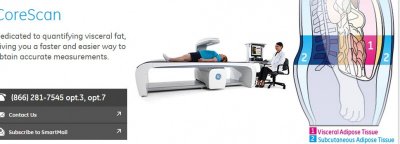You are using an out of date browser. It may not display this or other websites correctly.
You should upgrade or use an alternative browser.
You should upgrade or use an alternative browser.
Find out your body's fat, muscle and bone density with CoreScan DEXA
- Thread starter Nelson Vergel
- Start date
Nelson Vergel
Founder, ExcelMale.com
Int J Obes (Lond). 2016 Mar 22. doi: 10.1038/ijo.2016.50. [Epub ahead of print]
Correlation of visceral adipose tissue measured by Lunar Prodigy dual x-ray absorptiometry with MRI and CT in older men.
Cheung AS1, de Rooy C1, Hoermann R1, Gianatti EJ1,2, Hamilton EJ2, Roff G1, Zajac JD1, Grossmann M1.
Author information
1Department of Medicine (Austin Health), The University of Melbourne, Australia.
2Department of Endocrinology and Diabetes, Fiona Stanley Hospital, Perth, Australia.
Abstract
Quantification of abdominal visceral adipose tissue (VAT) is important to understand obesity-related comorbidities. We hypothesised that DXA measurements of VAT would correlate with traditional gold standards of MRI and CT in older men. Deming regression and Bland Altman plots were used to assess the agreement between VAT measured simultaneously by DXA and MRI (n=95) in a cohort of older males participating in a randomized trial of testosterone replacement for diabetes. We also correlated DXA with single-slice CT (n=102) in a cohort of older males undergoing testosterone deprivation for prostate cancer. Lunar Prodigy DXA scanners using enCORE software was used to measure VAT. DXA VAT volume strongly correlated with MRI VAT volume (r=0.90, P<0.0001) and CT VAT area (r=0.83, P<0.0001). As DXA assesses VAT volume in a smaller compartment than MRI, Bland-Altman analysis demonstrated DXA systematically underestimated VAT by an approximately 30% proportional bias. DXA VAT volume measured by Lunar Prodigy DXA scanners correlate well with gold standard MRI and CT quantification methods, and provides a low radiation, efficient, cost-effective option. Future clinical studies examining the effects of interventions on body composition and regional fat distribution may find DXA an appropriate volumetric method to quantify VAT.International Journal of Obesity accepted article preview online, 22 March 2016. doi:10.1038/ijo.2016.50.
Correlation of visceral adipose tissue measured by Lunar Prodigy dual x-ray absorptiometry with MRI and CT in older men.
Cheung AS1, de Rooy C1, Hoermann R1, Gianatti EJ1,2, Hamilton EJ2, Roff G1, Zajac JD1, Grossmann M1.
Author information
1Department of Medicine (Austin Health), The University of Melbourne, Australia.
2Department of Endocrinology and Diabetes, Fiona Stanley Hospital, Perth, Australia.
Abstract
Quantification of abdominal visceral adipose tissue (VAT) is important to understand obesity-related comorbidities. We hypothesised that DXA measurements of VAT would correlate with traditional gold standards of MRI and CT in older men. Deming regression and Bland Altman plots were used to assess the agreement between VAT measured simultaneously by DXA and MRI (n=95) in a cohort of older males participating in a randomized trial of testosterone replacement for diabetes. We also correlated DXA with single-slice CT (n=102) in a cohort of older males undergoing testosterone deprivation for prostate cancer. Lunar Prodigy DXA scanners using enCORE software was used to measure VAT. DXA VAT volume strongly correlated with MRI VAT volume (r=0.90, P<0.0001) and CT VAT area (r=0.83, P<0.0001). As DXA assesses VAT volume in a smaller compartment than MRI, Bland-Altman analysis demonstrated DXA systematically underestimated VAT by an approximately 30% proportional bias. DXA VAT volume measured by Lunar Prodigy DXA scanners correlate well with gold standard MRI and CT quantification methods, and provides a low radiation, efficient, cost-effective option. Future clinical studies examining the effects of interventions on body composition and regional fat distribution may find DXA an appropriate volumetric method to quantify VAT.International Journal of Obesity accepted article preview online, 22 March 2016. doi:10.1038/ijo.2016.50.
PAUL-E
Member
would it bee possible to make a location list with a rough estimated cash price?These scans are great - the problem in many areas is finding a place to get a scan.
Online statistics
- Members online
- 1
- Guests online
- 6
- Total visitors
- 7
Totals may include hidden visitors.
Latest posts
-
-
-
-
-
-
-
cheap HCG (23usd/10k IU) - reliableRX - experience
- Latest: t_spacemonkey
-
-
-
-
© Copyright ExcelMale
















